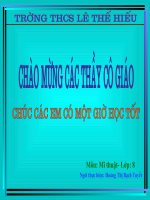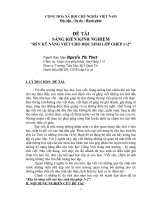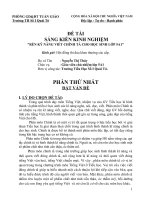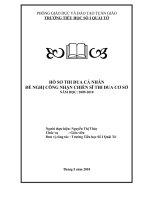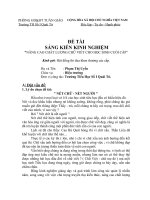Bai tap de tai TA
Bạn đang xem bản rút gọn của tài liệu. Xem và tải ngay bản đầy đủ của tài liệu tại đây (114.19 KB, 23 trang )
Ministry of Education and training
Hanoi University of Education
Faculty of English
A STUDY ON CLASSROOM ACTIVITY
AND ITS APPLICATION
INSTRUCTOR : Nguyen Mai Huong, M. A
STUDENT : Ngo Thi Hue
GROUP: : 2
Academic Year: 2007- 2008
Hanoi, August- 2008
ACKNOWLEDGEMENT
During the process of writing this assignment, I have been fourtunate to receive
support and assistance from a variety of people.
First and foremost, I wish to express my deepest gratitude to my instructor,
Nguyen Mai Huong, M.A for her expertise in scholarly instruction, valuable
guidance and intellectual support to my study.Without her advice and instruction I
can’t complete this assignment .
My special thanks also come to the grade 7 student at Huong Mac secondary
school, Tu Son – Bac Ninh who have actively participated in doing the serveys and
respond to my interviews .
Finally, I owe a great debt of gratitude and appreciation to my family, my relatives
especially my husband who encouraged and help me to carry out this assignment .
TABLE OF CONTENTS
CHAPTER I: INTRODUCTION
I.1. Rationale.
I.2.Characteristics of teaching and learning situation at Huong Mac I secondary
school .
CHAPTERII: IMPLEMENTATION.
A. Theoretical background .
I . Overview of reading:
I.1. What is reading .
I.2 . The importance of reading.
I.3. Reading procedure .
I.3.1. Pre-reading stage.
I.3.2. While- reading stage .
I.3.3 Post- reading stage .
II. Overview of pre-reading stage .
II.1. Pre-reading stage and its importance to reading comprehension .
II.2. Funtions of pre-reading stage in reading comprehension .
III. Types of interaction activities in a reading lesson at pre- reading stage .
IV.Activities at the pre-reading stage .
B. Procedures of the study.
I . Methodology of the study .
I.1. The subjects of the research .
I.2. Methods of the research .
C. Data analysis .
D. Findings and recommendations .
I. Findings
I.1. Students .
I.2. Teaching and learning conditions .
II. Recommendations .
II.1 .How to use the activity : T /F prediction
II.2.Adjustment to suit the teaching and learning condition
CHAPTER III: CONCLUSIONS .
III.1. Summary
III.2. Limittation of the st
CHAPTER I : INTRODUCTION.
I.1 . Rational :
The rapid development of the ralationship between Vietnam and countries all over
the world has resulted in a great demand for English language learning throughout
the country. The need is , nowadays, ever greater because there is a considerable
number of peoplewho want to use English effectively for many surposes- academic
students, professional success and international communication. Having recognized
the importance of English, the ministry of Education and training ( MOET) has
recently decided that English is a compulsory subject in secondary schools . One
example is the coming into use of the new text book, which requires the teachers to
alter their teaching methods . Thus, there is a tendency for them now to focus more
on Communicative approach instead of the Grammar and Translation . However , at
present, English language teaching in Vietnamese secondary schools especially in the
rural area, is still far from satis-faction. Changes are said to be modest in the real
teaching and learning English at schools . The fact that students are afraid of learning
English and fail to actully use the language or find it difficult to understand its use in
daily life communication is undeniable .
As far as we know , reading plays an important role but pre-reading stage is not
less important . The lack of pre-reading activities may lead to the ss’ low motivation
and interest in reading classes . Among varieties of pre-reading activities it is the
teacher’s role to choose the most appropriate one to use . Each activity has its
characteristics . It may be suitable with these studnets but unsuitable with others ,in
these schools but not in others . Hense the writer decide to choose one activity ( T/F
prediction ) for her pre-reading stage and she wants to make it suitable with her
Grade 7 students, at Huong Mac I secondary school in Bac Ninh .
I.2. Characteristics of teaching and learning situation at Huong Mac I secondary
school .
The reasons for choosing Huong Mac I secondary school to be the research
setting are: First, I have been teaching at Huong Mac I for many years. Thus , I had
more chances to get to know about the teaching and learning condition here. Second,
my school is about 20 kilometres from the centre of Bac Ninh city and is a typical
rural school where there are difficulties both teachers and students have to face up
with like lack of essential conditions supplyingfor learning and teaching New English
6 text book, especially its reading skill.
This paper hopefully will make a small contribution to make Huong Mac I
secondary school teachers’ and students aware of their own situation of teaching and
learning reading in general and carry out the pre-reading stage in particular . The
writer’s expectation is to discuss and find out the best way to conduct T/F prediction
activity when teaching reading comprehension at grade 7 more effectively .
CHAPTER II : IMPLEMENTATION .
A . Theoretical background :
I : Overview of reading:
I.1.What is reading ?
Reading is common habit in human life and one of four main skills of a foreign
language learner . However , it is impossible to find a definition or explaination of
reading which is acceptable to everyone . There have been numerous definition of
reading and each of them reflects an individual opinion of reading .
William, E ( 1984:2) states in a simple defition of reading : “It is a process
whereby one looks at and understands what has been written”.
Being the same as William’s view is Harmer’s ( 1989: 153) . He started that
reading is ( An excercise dominated by eyes and the brain. The eyes receive message
and the brain then has to work out the significance of these massage ”.
Another definition is “ Reading is a receptive language precess in that it starts
with a linguistic surface presentation encoded by a writer and ends with meaning
which the reader contructs . there is thus an essential interaction between language to
thought” ( Arrell ( 1988: 12) ) .
From the above definition , it can come to nuderstand that reading is an interative
constructive process in which readers comprehend , interpret , and respond to text
according towhat they already know .
I.2. The importance of reading:
In daily life, research takes an undoubtedly important role . First and Foremost,
the ability to read provides people with opportunities to get access to education . In
out literate society, it is hard to imagine any skilled work that does not require the
ability to read . More over, further education depends on quality and quality of
reading as all important. Study skills require quick , efficient and imaginative reading
. Reading also enhances general knowledge . The more we read the more background
and crosscultural knowledge we acquire and the more books we find possible to
understand .
In mastering a foreign language , reading is one of the four basic language skills
that any students has to acquire . Concerning the roles of reading in a language
learning course , William , E ( 1996: 10) points out the following suggested answers
to the question: “ why should teachers want learner to read a foreign language ?”
• So that learners can have further practice of language that they have
already met through listening and speaking .
• So that learners can learn how to make sense of text, in order to extract the
information they need from them .
• So that learners can find enjoyment through reading .
• So that learners can relax from time to time in the classroom .
To sum up,reading ability will be developed best in association with writing
,listening and speaking activities . Even in those courses that may be labeled
“reading” your goals will be best achieved by capitalizing on the interrelationship of
skills , especially the reading- writing connection . Therefore , students who enjoy
reading in the foreign language may become motivated to learn that language in
general , which is a boost for any teacher.
I.3. Reading procedure :
According to CLT approach , a reading lesson has three stages including pre-
reading , while-reading , and post-reading . This approach is considered to be both
scientific and art . Being scientific shown is that reading procedure is divided into
clear stages , so designing activities becomes more easily , and being art and creative
are that teachers are able to apply suitale reading techniques depending on conditions
of each class or types of learners to teach reading most effectively in each stage .
Each stage obviously has its own aims and consist of specific activities . However ,
these stages are inter-related to each other and exploiting the lesson in their inter-
relationship would help make the lesson as effective as it can be .
I.3.1 : Pre-reading stage :
Pre-reading stage is carried out before students begin reading the text. It
involves preraring studnets for what they are about to read, also it plays a decisive
role in the while process of teaching reading lesson . According to William ( 1984:
37 ) , The aims of this stage are :
- to introduce and arouse interest in the topic .
- to motivate learners by giving a reason for reading .
- to provide some language preparation for the text .
To achieve these above purposes , Doff (1988:59) gave some general following
activities :
- Giving a brief introduction to the text .
- Presenting new vocabulary .
- Revising grammatical structures .
- Giving guiding questions .
- Open prediction
- Pre-question .
- Net work.
- Ordering.
- Ordering picture .
I.3.2 : While-reading stage :
It is the main part of reading lesson its aims are :
- to help understanding of the writer’s purpose .
- to help understanding of the text structure .
- to help clarify text content .
( Williams , 1986 :5 )
This stage is used mainly for silent reading . there are a munber of activities ,
depending on the requirements of reading of the reading lesson , used at this stage .
Grelllet ( 1981: 5) mentioned some activities like :
- Skimming for main ideas .
- Scanning to locate specially required imformation .
- Understanding relation between parts of the text thruogh lexical cohesion
devices .
- Multiple choice .
- Gap fill .
- Anwer given .
- Grids .
- Maching .
- Comprehension question .
- Recognizing indicators in discourse ,etc .
I.3.3 : Post-reading stage :
It is the stage after finishing all the required activities at the while reading stage
. At this stage , activities can be carried out to gain some aims that Williams
mentioned :
- to consolidate or reflect upon has been read .
- to relate the text to the learner’s own knowledge , interest or views .
The activities at this stage can be :
- Discussing question.
- Pole-playing .
- Gap-filling .
- Brainstorming personal ideas on the theme of the text .
- Summarizing the text .
- Arranging the events in order .
These activitiesare implemented after students have thoroughly understanding
of the text . The more comprehensively they get , the better they perform .
Overall , reading is an interactive-contructive process so the three-part frame
work mentioned above will help teacher to conduct a reading lesson well , it means
that, being aware these stages , teacher can not only deal with students’ motivation
problems but also with language problems and the selection or construction of
reading activities and related exercises .
II .Overview of the pre-reading stage :
Generally, no one reads because they have to but because they want to . We
usually read with a purpose ,such as finding out something or checking or clarifying
more information ,or even reading for pleasure . Further more , we do not normally
read with completely empty mind . At least , we have some ideas of what we are
going to read about , of things we want to know or we may predict or expect to find
out some things .
II.1 : Pre-reading stage and its importance to reading comprehension ?
We have understood that reading is an interactive- contructive process in which
readers comprehend, interpret, and respond to text according to what they already
know ,so “ pre-reading, thinking in advance about a topic before read , helps you
prepare for the words on the page” ( Wiener, 1991 :61 ) . Moreover , “ all language
use in real life occurs in situation which allows the language user to reply heavily on
anticipation and context . It is correspondingly artificially difficult to ask ss to read
an unseentext with no preparation.” ( Lewi , 1985: 98 ) . For example , pre-reading
activities such as title discussion and vocabulary training have been shown to
effective in decreasing oral reading errors and ncreasing reading rate and
comprehension across a range of reading levels . The benefical effects that pre-
reading activities designed to enrich the relevant experiential context of the learner
may have on both decoding and reading comprehension has been a focus on
empirical endeavour for over 55 years ( Smith ,1963 ) . The general purpose of such
activities is to either activate appropriate knowledge structures or to provide
knowledge that the reader may lack . The writers have reported that lack of
understanding of context , or culturally loaded background knowledge assumed by
the author , often makes comprehension difficult for the ESL reader ( Jonhson, 1981 )
, Hudson ( 1982 ) , Taglieberetal ( 1988) and Tudor (1988) have all demonstrated
benefits that the provision of context as a pre-reading instructional activity can have
on comprehension- particularly with low and medium proficiency ESL students . This
can be stated more simply through Winer’s saying ( 1991) : “If you consider the topic
before hand , you will find the writer’s ideas a little more familiar than if you jumped
into the reading without prior thought.”
Is short, pre-reading activities are most important at lower levels of language
proficiency and at earlier stages of reading instruction. As students become more
proficient at using reading strategies , teachers will be able to reduce the amount of
guided pre-reading and allow students to do these activities themselves .
II.2 : Functions of pre-reading stage in reading comprehension .
To understand the function of pre-reading stage , let’s take consideration into
some following diagram stated by Sandra Siberstein .
For students
Reading/ thinking activities before reading .
Reading begins
Skim the text , using information from teacher about the task/ purpose .
From ideas what the text is about how it is organized .
Use these ideas to activate prior knowledge of content and organizational patterns .
More than recall or rewiew.
Scanning files and selecting relevant
information and deciding if information
is related .
If................. More inferences



